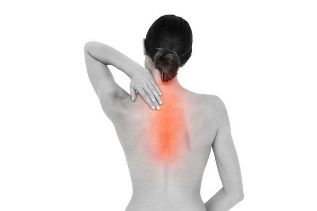
Osteochondrosis affecting the thoracic spine is often disguised as a pathology of internal organs. It is manifested by heart pain, shortness of breath, shortness of breath and panic attacks. Therefore, the diagnosis of thoracic osteochondrosis is somewhat difficult. After its detection, conservative treatment is performed using drugs, physiotherapy, exercise therapy. And with severe damage to the thoracic discs and vertebrae, surgery is required.
Brief description of the disease
Chest osteochondrosis is a degenerative-dystrophic disease of the spine. In the early stages of its development, the intervertebral discs are slowly destroyed. They become thin, brittle and radial cracks appear on their surface. To stabilize the thoracic portion affected by osteochondrosis, the bone tissue of the vertebrae grows with the formation of acute growths - osteophytes. This leads to a sharp reduction in mobility, compression of blood vessels and spinal roots.Degrees of pathology
Degree of osteochondrosis - a set of symptoms that characterize a specific radiographic stage. The more deformed the discs and vertebrae, the more intense the clinical manifestations. The severity of the pathology always determines the tactics of treatment, it must be taken into account when choosing drugs and methods of their use.Degree
X-ray images usually show no changes. But the intervertebral disc has already begun to collapse due to the inability to retain moisture, which is necessary for the restoration of its tissues. Sometimes there is a slight discomfort in the back, which disappears quickly after a short rest. Grade 1 osteochondrosis is usually discovered by chance when diagnosing other diseases.
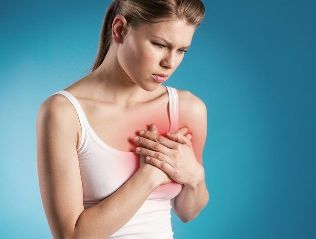
Degree II
The fibrous ring relaxes, fibrous. One of the cracks in the surface of the disc grows, the pulposus nucleus extends there. X-rays show a reduction in the distance between adjacent vertebral bodies due to the reduction in the height of the disc. As a result of the constant compensatory muscle tension, the mobility of the chest area is limited and moderate painful sensations appear.
III degree
The integrity of the fibrous ring is violated, so that the nucleus of the nucleus is compressed by it. A hernia protrusion forms - the main cause of severe symptoms and serious complications of osteochondrosis in the chest. The vertebral bodies are deformed, individual osteophytes are formed. The pain in the chest area becomes constant, the range of motion in the spine is significantly reduced.
IV degree
X-ray images clearly show the growth of connective tissue, the formation of multiple osteophytes. Adjacent vertebral bodies are blocked, immobilized. Rheumatoid syndrome occurs, often occurs discogenic myelopathy - compression of the spinal cord, dangerous for its irreversible consequences. A person does not serve himself in everyday life, loses the ability to perform professional duties.Causes of thoracic spine osteochondrosis
Chest osteochondrosis in people over the age of 40-45 develops due to the natural aging of the body: slowing down the recovery reactions, reduction of collagen production, which causes elasticity, strength of the ligaments. At a young age, it occurs as a result of increased stress on the spine or in the context of pathologies that already exist in the body:- rheumatoid arthritis, systemic lupus erythematosus, scleroderma, ankylosing spondylitis.
- Congenital and acquired abnormalities, including kyphosis, scoliosis.
Previous spinal injuries, a sedentary lifestyle, and a lack of vitamins and minerals in the body can cause premature disc damage.
Characteristic signs and symptoms of the disease

Chest osteochondrosis develops gradually, initially without appearing. In this course lies the danger. A person gets mild back pain and discomfort for muscle cramps after a hard day, chores or gardening and does not seek medical help. Therefore, patients are usually diagnosed with a pathology of 2-3 degrees of severity, which is difficult to treat conservatively.
In the beginning
During the period of deterioration, the pathology can manifest as pain between the shoulders, which occurs when bending, turning the body. The range of motion decreases and there are many specific signs of relapse.
Chest pain
With osteochondrosis, chest pains appear first. They are not clearly identified, they can be given to the hands, the key, the ribs. The pain in the heart is severe or moderate, looks like an angina attack and is not eliminated by taking nitroglycerin. Sometimes they are similar to the sensations that appear during the worsening of cholecystitis, pancreatitis. But unlike pancreatic or gallbladder damage, pain is not accompanied by increased gas production, heartburn and bloating.
Restriction on the chest
Pain between the shoulders is sometimes accompanied by a feeling of shortness of breath on inhalation. A person is expected to be afraid, not to understand the reasons for this situation. Doctors recommend not to panic, but to sit and measure the pulse. If the value obtained does not exceed 100 beats per minute, then the chance of lung or heart failure is extremely low.
Other symptoms
Gradually, the symptoms of osteochondrosis are aggravated by a sensitivity disorder. There are sensations of numbness, tingling, crawling. Occasionally there is a resemblance to panic attacks. They are characterized by fear, increased heart rate, excessive sweating and cold sweats. If these symptoms are accompanied by chest pain, then it is necessary to take nitroglycerin and call a doctor. A similar set of symptoms may indicate a myocardial infarction.
The spinal roots, located in the thoracic region, moisturize the internal organs. When irritated, compressed, the work of the gastrointestinal tract and liver is disrupted. Peristaltic disorder, epigastric pain, heartburn, belching.
Indications in the subacute stage
After an exacerbation, the subacute stage of the course of thoracic osteochondrosis begins. Pain and breathing problems persist, but are much less severe. A person is no longer looking for a comfortable position of the body for a long time, in which the pain is not felt. The duration of the hypoxic stage is up to two weeks. If all medical recommendations are followed, a recession occurs, which is characterized by the absence of severe symptoms. Violation of the treatment leads to a new worsening of osteochondrosis.
Delete
In the recession stage, mild discomfort may occur when the weather changes or hypothermia. Acute pain occurs only with osteochondrosis 2-4 degrees of severity due to excessive rotation or inclination of the body. Exacerbations of chronic conditions, stress, increased physical activity and prolonged stay in one position of the body can cause another relapse.
Principles of diagnostic diseases
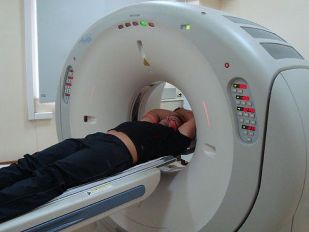
The neurologist makes an initial diagnosis based on the patient's complaints, the memory data. On external examination, he discovers signs in the chest area, with pressure at which the pain occurs. Performing functional tests allows you to assess the safety of reflexes, to detect sensitivity disorders. Of the organic methods, radiography is the most informative. But for a detailed study of the spine, CT, MRI can be performed. To rule out diseases of the cardiovascular system, patients are given an ECG.
First aid for deterioration
The pain of relapse of thoracic osteochondrosis is acute, penetrating, so a person should receive first aid. It should be soothed, placed on a hard surface, covered with a warm blanket. If the relapse is accompanied by increased heart rate, shortness of breath, increased stress, then you should call a doctor. Any non-steroidal anti-inflammatory drug can be taken to relieve pain between the shoulders.
How to treat breast osteochondrosis
Only a holistic approach to treatment will get rid of all the symptoms of osteochondrosis, slow down or stop it from spreading to healthy discs and vertebrae. With pathology of 1-2 degrees of severity, conservative methods of treatment are used. For osteochondrosis 3-4 degrees, the formation of large hernias is typical. Surgical treatment may be needed to relieve pressure on the blood vessels and vertebrae.Preparations
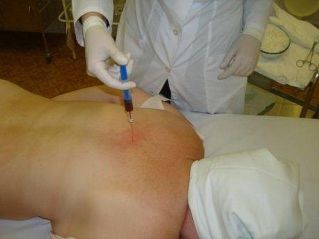
Drugs of various clinical and pharmacological groups are used in the treatment of thoracic osteochondrosis. In the initial stage, agents for parenteral administration are usually used, which provide a rapid therapeutic effect. A few days later, the injectable solutions are replaced with safer tablets, ointments and plasters.
Non-steroidal anti-inflammatory drugs (NSAIDs)
NSAIDs have a strong analgesic, anti-inflammatory, anti-edematous effect. Intramuscular administration of solutions allows the cessation of acute pain. Topical application agents are used to eliminate mild discomfort between the shoulders. And with moderate pain, NSAIDs for oral administration are doing well.Muscle relaxants
Muscle relaxants are used to relieve muscle spasms in response to severe pain. Most often, the treatment of osteochondrosis in the chest begins with the intramuscular administration of drugs, which, in addition to the muscle relaxant tolperisone, include anesthetic.
Chondroprotectors
In case of grade 1 pathology, taking chondroprotectants helps to repair damaged discs. In other cases, they are prescribed to improve metabolism in the affected part of the spine, to prevent the progression of the disease.
B vitamin preparations
Their use helps to increase blood flow, improve the function of the peripheral nervous system, restore nutrition and hydration. The B vitamin complex has a beneficial effect on degenerative diseases of the nerves and the motor system.
Physiotherapy exercises
In case of grade 1 thoracic osteochondrosis, daily exercise can do you no medication. Recovery is done by strengthening the muscles, improving the blood supply to tissues with nutrients. In other cases, exercise and regular training help prevent healthy vertebrae from participating in the catastrophic process and prolong the recession.
Band from upright position
In an upright position, the following therapeutic exercises are more therapeutically effective:
- put your palms on your shoulders, bend forward while lifting your bent legs, as if trying to reach the opposite knee with your elbow.
- raise your left hand up, lean to the right. Perform the exercise in the opposite direction.
- Spread your legs shoulder width apart, raise your arms. Lean forward, touching the opposite foot with your palm.
The number of repetitions is 10-12 times in 2-3 sets.
From a prone position
For these exercises, you will need a exercise mat or a thick, folded blanket:
- lie on your stomach, raise your arms and legs at the same time.
- lying on your back, lift your upper body, stretch your palms on your feet.
- lying on your back, bend one leg, wrap it behind the other, trying to touch the floor with your knee.
Each exercise should be done 7-10 times.
Meeting
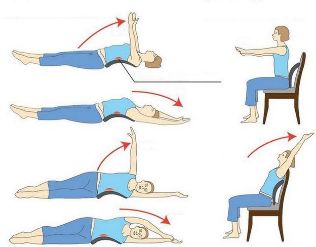
When performing such exercises, sharp wide movements, including rotation, should be avoided:
- sitting on the floor, stretched forward, trying to touch the opposite foot with your palm.
- Sitting in a chair or stool, stretch your arms forward and slowly turn from side to side.
- while sitting on the floor, wrap your arms around your knee, pull it as close to your chest as possible.
In the first lessons, the exercises should be repeated 5-7 times, after about a month - 15-20 times.
Physiotherapy
Magnetic therapy, laser therapy, UHF therapy, sinusoidal currents, shock wave therapy, paraffin and ozokerite applications are used to treat osteochondrosis in the chest. In case of exacerbations, electrophoresis is performed, pride with glucocorticosteroids, anesthetics, B vitamins, chondroprotectors.Massage
A massage performed by a specialist helps to eliminate pain between the shoulders, to relax the spasmodic skeletal muscles.
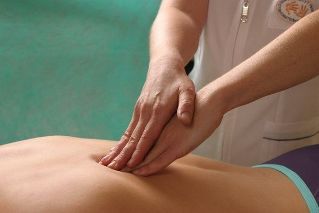
In case of osteochondrosis, all types of massage are therapeutically effective - classic, vacuum, acupuncture, connective tissue. At home, self-massage is conveniently done using a long-lasting wooden or electric massage.
Acupuncture
Acupuncture is a method of treating pathology by inserting needles into bioactive sites in the human body. They are thin, short, so when piercing the skin, only mild discomfort occasionally occurs. But even this effect is enough for the production of substances in the body with analgesic and anti-inflammatory effects.Diet
Nutritionists advise patients with osteochondrosis of the chest to give up fatty meats, rich soups, smoked meats, homemade and factory-made marinades. It is necessary to limit the amount of salt in the diet, which causes the formation of edema. Every day you should drink about 2. 5 liters of fluid - water, vegetable juices, berry drinks, fruit compotes.
Folk remedies
Decoctions and infusions of herbs, ointments, alcohol and rubbing oil, compresses are allowed by neurologists to be used after the main treatment. Folk remedies are used to eliminate mild pain between the shoulders, sometimes occurring after physical exercise.
Celery root
Peel a large celery root, finely chop it, squeeze the juice. Add 100 grams of chopped fresh celery. Take 3 tablespoons up to 4 times daily with meals to clean the vertebral structures from harmful salt deposits.Sunflower Root
Pour a teaspoon of dried crushed sunflower roots with a glass of warm water. Bring to a boil, simmer on low heat for 20 minutes, cool under the lid, drain. Drink 3-4 times a day.
Ointment at home
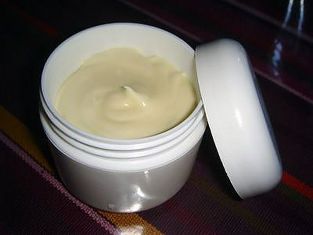
In a mortar, grind a tablespoon of turpentine and thick honey, add 2 drops of essential oil of juniper, rosemary, eucalyptus. Inject in small doses 100 g of medical Vaseline Mix, transfer to a jar, store in the refrigerator, rub on the back for pain.
During pregnancy
Many systemic analgesics are contraindicated during pregnancy, so neurologists prefer medications for external use - ointments, gels, patches. If you can not do without taking pills, then their doses are significantly reduced. During childbirth, the main methods of treatment for osteochondrosis of the breast are massage and exercise therapy.
Possible consequences
In the absence of medical intervention, thoracic osteochondrosis can cause pneumosclerosis, arrhythmias, vascular dystonia, deterioration of the gastrointestinal tract, decreased sexual and reproductive function in women and men.
Prevention and prognosis
The prognosis is favorable with early detection of the disease, appropriate, comprehensive treatment. If complications of thoracic osteochondrosis have developed, then only adherence to all medical recommendations will allow a consistent remission to be achieved.
As a precaution against pathology, neurologists recommend excluding factors that cause it from the normal way of life. This is overweight, low physical activity, deficiency of vitamins and minerals, excessive stress on the spine.












































